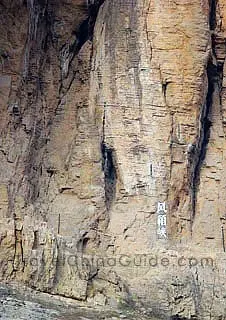Bellows Gorge & Meng Liang Stairway
Bellows Gorge (Feng Xiang Xia)
 |
| Bellows Gorge |
The best place to view the gorge is the plank road. As the coffins lie over 32 feet high in the cliff, it is difficult to climb. So, the method used to suspend them in the cliff is a mystery that still puzzles people today.
Rhinoceros Looking at Moon
Among the scenery of Qutang Gorge, there is a huge stone in the shape of a rhinoceros looking at the moon. The stone lies on the top of the hill east of Kuijia Cave (Armour Cave) on the northern bank of the Bellows Gorge of Yangtze River. From a distance, the stone looks like a rhinoceros standing on top of the hill looking westward towards the moon. Hence the name Rhinoceros Looking at Moon.
It is best to admire the scenery in the owl-light. When dusk falls, the rhinoceros is silhouetted against the setting sun, leaving you an amazing picture and unforgettable impression.
Prior to the water rising due to the Three Gorges Dam Project, there were two such stones like the rhinoceros looking at the moon, one on the bank of the river at the foot of the hill and the other on the top of the hill. But now, the one along the riverbank is submerged in the river. The top stone is now easy to watch.![]() Legend about Rhinoceros Looking at Moon
Legend about Rhinoceros Looking at Moon
In fact, there are several scenic spots in China with the same name as this one, because not only the similar shape but also the interesting legend about Rhinoceros Looking at Moon.
The rhinoceros once was a sacred general in the Heaven Court. One day the Heaven Emperor designated him to come to the earth to deliver the Heaven's regulations on human's daily life. The regulations called on people to pay more attentions to proprieties rather than dining, with a slogan of 'Have one meal but three times to check the apparel a day'.
However, the careless rhinoceros was promptly attracted by the dazzling human world when he arrived. He consequently made a big mistake in passing the Heaven Emperor's order. The slogan was misrepresented as 'Have three meals but one time to check the apparel a day'!
The Heaven Emperor was angered by his deeds, so he penalized the rhinoceros to live on the earth forever. As a result, the rhinoceros had to stay here on the earth. He always looked at the moon when he was homesick.
Meng Liang Stairway & Hanging Monk Rock
On the remains of the Chalk Wall, are carved some square holes (each of one foot deep, 0.9 foot wide and 0.8 foot high). The holes are three feet in distance from each other, form a special 'Z' shape and reach to the mountainside. The holes are called Meng Liang Stairway by the local people. Close to the Meng Liang Stairway is a strange stone extending out of the precipice. As it resembles a monk hung upside down, the stone is called the Hanging Monk Rock (in Chinese Daodiao Heshangshi).
According to the legend, General Yang Jiye of the Northern Song Dynasty (960-1127) was killed by a treacherous court official. His corpse was buried on the Glanceat Home Terrace on the top of Mt. Baiyan (Mountain White Salt). One of his henchmencalled Meng Liang entered Qutang Gorge wanting to bring his skeleton back andbury it in his hometown. He cut holes and inserted wood every night and stopped his work before daybreak. However, his deed was discovered by a monk living inthe Baidi Temple opposite to the precipice Meng Liang climbed. The monk crowedlike a cockerel during the night causing all the cockerels in the Baidi Cityarea to crow. Meng Liang mistakenly thought that daybreak was coming and stoppedhis work. Later, he discovered the monk's behavior and hung him upside down onthe wall after killing him. For years, the monk became known as the Hanging Monk Rock.
As a matter of fact, the corpse of General Yang Jiye was not buried in Qutang Gorge Area; his legend only reflects the people's love for the general. The holescaved on the precipice were in fact the relics left by the ancient local peoplewhen they built the ancient plank road. And the Hanging Monk Rock is nothing more than a stalactite.